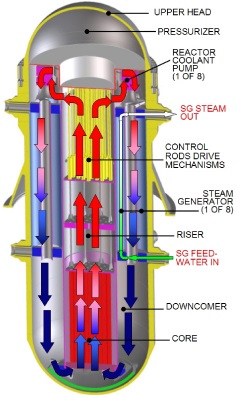Part Two of Two Parts (Please read Part One first)
Often, companies in other countries start out supplying parts for domestic reactors but then expand into the export market. Much of the international growth of nuclear component manufacture has been a result of Westinghouse, a U.S. based subsidy of the Japanese Toshiba company, seeking component sources outside of the U.S. Westinghouse's AP1000 reactors are being constructed in the U.S. and China. International sourcing of manufactured components has been around for decades but there can be problems.
A few years ago, Boeing admitted serious problems with their outsourcing of parts for their new Dreamliner 787 airplane. Boeing said that poor quality components were coming from outsourcers that were not under the direct control of Boeing. This lack of quality control could be disastrous in the construction of a nuclear power reactor from outsourced parts.
There is also a trade in nuclear expertise internationally with nuclear experts from the U.S., China, South Korea and Japan working on nuclear projects in other countries. Many of the highly-trained staff at nuclear installations worldwide are reaching the end of their careers and retiring. There are concerns in the nuclear industry that not enough nuclear engineers are being graduated from universities to resupply the existing power reactor staffing requirements to say nothing of the expanded requirements for all the new reactors under construction.
A new generation of what are called small modular reactors are being designed. These reactors which produce less than three hundred megawatts are designed to be built from modules that can be manufacture elsewhere and transported to the construction site. This will result in the expansion of the global trade in nuclear components. One problem with this trend is that fact that if the tolerances of the manufacturing process in a plant anywhere in the world slip, then all the reactors that use components or modules made in that plant will be at risk.
This surge in reactor construction has not been met with universal approval. The Fukushima nuclear disaster in Japan in March of 2011 resulted in Japan turning off all nuclear power reactors. They are just beginning to turn some of them on again. Germany decided to shut down all of their reactors. Reactor projects worldwide were stalled and some were abandoned. Some countries implemented new security and safety requirements for nuclear power reactors and demanded expensive upgrade to existing reactors.
Recently, there have been lawsuits in the European Union over the construction of nuclear power reactors. One of these suit involved outsourcing plans for nuclear fuel assemblies to countries outside of the European Union. Another suit has to do with challenges that a member nation is providing illegal subsidies to a reactor project.
Security concerns prompt calls for manufacturing all components inside the country where a reactor is located but the lower cost of international competition in the nuclear component market makes foreign built components attractive. Britain is having internal debates of the wisdom of allowing China to construct a Chinese designed reactor in England made from Chinese components and built by Chinese labor. Both security and safety concerns have been expressed.
For the moment, the fortunes of the nuclear industry are on the rise. World economic growth has slowed and some countries such as Japan, China, Russia and South Korea are hoping to stimulate their economies with the export of nuclear technologies. Developing nations are hoping that the construction of nuclear power reactors will help provide their economies with the power needed to expand. Unfortunately, if there is one major nuclear accident anywhere in the world, it will seriously impact the entire global industry. A robust international anti-nuclear movement continues to press for the abandonment of all nuclear power generation. The availability of cheap oil and natural gas in the short run as well as cheaper sustainable alternative energy sources in the long run will cut into the attractiveness of nuclear power for the public and investors. Time will tell.
Artist's concept of a small modular reactor:
